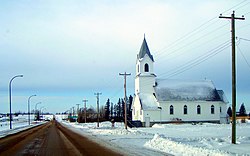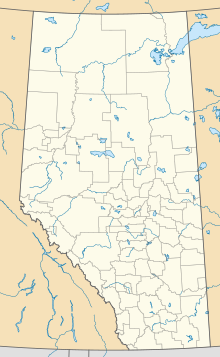Valhalla Centre
Valhalla Centre | |
|---|---|
 Valhalla Lutheran Church | |
Location of Valhalla Centre in Alberta | |
| Coordinates: 55°24′13″N 119°22′55″W / 55.4036°N 119.3819°W | |
| Country | Canada |
| Province | Alberta |
| Census division | No. 19 |
| Municipal district | County of Grande Prairie No. 1 |
| Government | |
| • Type | Unincorporated |
| • Reeve | Leanne Beaupre |
| • Governing body | County of Grande Prairie No. 1 Council
|
| Area (2021)[1] | |
| • Land | 1.22 km2 (0.47 sq mi) |
| Elevation | 735 m (2,411 ft) |
| Population (2021)[1] | |
| • Total | 40 |
| • Density | 32.7/km2 (85/sq mi) |
| Time zone | UTC−7 (MST) |
| • Summer (DST) | UTC−6 (MDT) |
Valhalla Centre is a hamlet in northern Alberta, Canada within the County of Grande Prairie No. 1.[2]
It is located in the Peace River Country at the junction of Highway 59 and Highway 723, northeast of the Village of Hythe and west of the Town of Sexsmith. It is approximately 40 kilometres (25 mi) east of the British Columbia border and has an elevation of 735 metres (2,411 ft).
The hamlet is located in Census Division No. 19 and in the federal riding of Peace River.
History
[edit]The hamlet was founded in 1912 by Scandinavians that moved north from Edson. It was named by Reverend Halvar N. Ronning after Valhalla, Odin's hall in Norse mythology. The first post office was established in 1916. The settlement grew around a creamery until 1945. The Melsness Mercantile building was built in 1925, and functioned as a store and post office until 1951.[3] Today it hosts a museum dedicated to the Scandinavian heritage of the area, and was declared a Provincial Historic Site.
Demographics
[edit]| Year | Pop. | ±% |
|---|---|---|
| 1941 | 59 | — |
| 1951 | 79 | +33.9% |
| 1956 | 67 | −15.2% |
| 1961 | 58 | −13.4% |
| 1966 | 59 | +1.7% |
| 1971 | 36 | −39.0% |
| 1976 | 32 | −11.1% |
| 1981 | 45 | +40.6% |
| 1986 | 48 | +6.7% |
| 1991 | 42 | −12.5% |
| 1991A | 44 | +4.8% |
| 1996 | 48 | +9.1% |
| 2001 | 52 | +8.3% |
| 2006 | 60 | +15.4% |
| 2011 | 45 | −25.0% |
| 2016 | 15 | −66.7% |
| 2021 | 40 | +166.7% |
| Source: Statistics Canada [4][5][6][7][8][9][10][11][12][13][14][15][16][17][1] | ||
In the 2021 Census of Population conducted by Statistics Canada, Valhalla Centre had a population of 40 living in 19 of its 22 total private dwellings, a change of 166.7% from its 2016 population of 15. With a land area of 1.22 km2 (0.47 sq mi), it had a population density of 32.8/km2 (84.9/sq mi) in 2021.[1]
As a designated place in the 2016 Census of Population conducted by Statistics Canada, Valhalla Centre had a population of 15 living in 9 of its 9 total private dwellings, a change of -66.7% from its 2011 population of 45. With a land area of 1.22 km2 (0.47 sq mi), it had a population density of 12.3/km2 (31.8/sq mi) in 2016.[17]
Economy
[edit]The economy is centred on farming and stock raising.
Amenities
[edit]The hamlet has a church (Valhalla Lutheran Church), curling rink, skating rink, museum and K-8 school (Valhalla Community School). The school is one of 13 publicly funded Alberta Chartered Schools.
See also
[edit]References
[edit]- ^ a b c d "Population and dwelling counts: Canada and designated places". Statistics Canada. February 9, 2022. Retrieved February 10, 2022.
- ^ "Specialized and Rural Municipalities and Their Communities" (PDF). Alberta Municipal Affairs. June 3, 2024. Retrieved June 14, 2024.
- ^ Discover the Peace Country. "Valhalla Centre". Retrieved February 14, 2008.
- ^ Ninth Census of Canada, 1951 (PDF). Vol. SP-7 (Population: Unincorporated villages and hamlets). Dominion Bureau of Statistics. March 31, 1954. Retrieved September 22, 2024.
- ^ Census of Canada, 1956 (PDF). Vol. Population of unincorporated villages and settlements. Dominion Bureau of Statistics. October 25, 1957. Retrieved September 23, 2024.
- ^ 1961 Census of Canada: Population (PDF). Series SP: Unincorporated Villages. Vol. Bulletin SP—4. Ottawa: Dominion Bureau of Statistics. April 18, 1963. Retrieved September 25, 2024.
- ^ Census of Canada 1966: Population (PDF). Special Bulletin: Unincorporated Places. Vol. Bulletin S–3. Ottawa: Dominion Bureau of Statistics. 1968. Retrieved September 25, 2024.
- ^ 1971 Census of Canada: Population (PDF). Special Bulletin: Unincorporated Settlements. Vol. Bulletin SP—1. Ottawa: Statistics Canada. 1973. Retrieved September 25, 2024.
- ^ "Geographical Identification and Population for Unincorporated Places of 25 persons and over, 1971 and 1976". 1976 Census of Canada (PDF). Supplementary Bulletins: Geographic and Demographic (Population of Unincorporated Places—Canada). Vol. Bulletin 8SG.1. Ottawa: Statistics Canada. 1978. Retrieved September 26, 2024.
- ^ 1981 Census of Canada (PDF). Place name reference list. Vol. Western provinces and the Territories. Ottawa: Statistics Canada. 1983. Retrieved September 26, 2024.
- ^ 1986 Census of Canada (PDF). Population. Vol. Unincorporated Places. Ottawa: Statistics Canada. 1988. Retrieved September 26, 2024.
- ^ 91 Census (PDF). Population and Dwelling Counts. Vol. Unincorporated Places. Ottawa: Statistics Canada. 1993. Retrieved September 26, 2024.
- ^ 96 Census (PDF). A National Overivew: Population and Dwelling Counts. Ottawa: Statistics Canada. 1997. Retrieved September 26, 2024.
- ^ "Population and Dwelling Counts, for Canada, Provinces and Territories, and Census Divisions, 2001 and 1996 Censuses - 100% Data (Alberta)". Statistics Canada. August 15, 2012. Retrieved September 19, 2024.
- ^ "Population and dwelling counts, for Canada, provinces and territories, and designated places, 2006 and 2001 censuses - 100% data (Alberta)". Statistics Canada. July 20, 2021. Retrieved September 19, 2024.
- ^ "Population and dwelling counts, for Canada, provinces and territories, and designated places, 2011 and 2006 censuses (Alberta)". Statistics Canada. February 8, 2012. Retrieved September 19, 2024.
- ^ a b "Population and dwelling counts, for Canada, provinces and territories, and designated places, 2016 and 2011 censuses – 100% data (Alberta)". Statistics Canada. February 8, 2017. Retrieved February 13, 2017.

